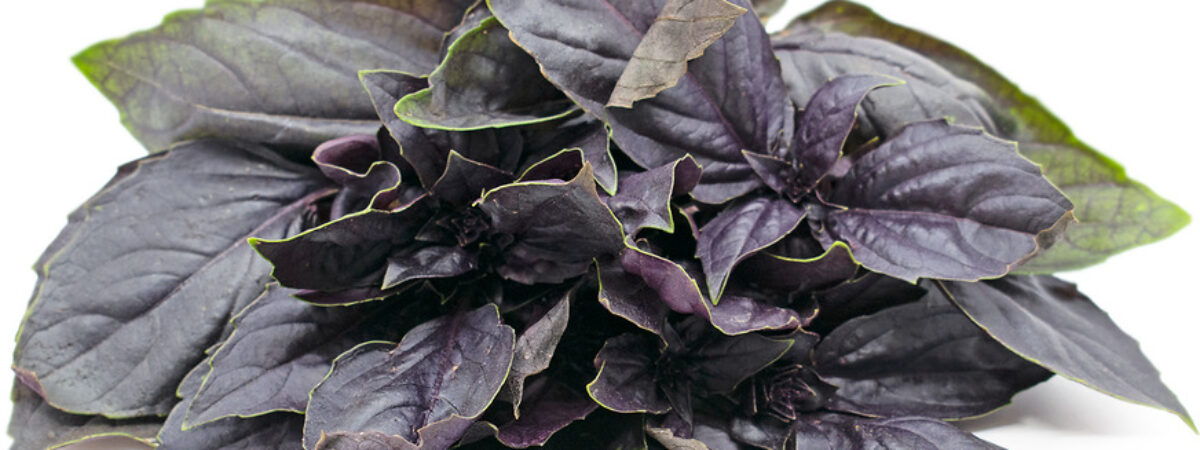Looking for a pop of bold color in your garden or indoor plant collection? Look no further than Red Rubin! This stunning plant is known for its deep, rich burgundy leaves that are sure to turn heads.
But how can you ensure your Red Rubin stays healthy and vibrant?
In this post, we’ll explore everything you need to know to grow and care for Red Rubin, from choosing the right soil to providing proper lighting and moisture.
Whether you’re a seasoned plant parent or just starting out, you won’t want to miss these tips for keeping your Red Rubin looking its best. So let’s dive in and discover the secrets to cultivating this striking plant!
What is Red Rubin Basil?
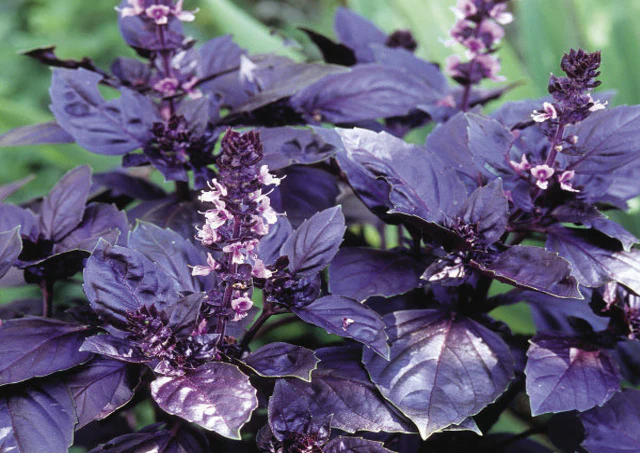
Red Rubin basil, also known as Dark Opal basil, is a unique and visually striking variety of basil that is known for its deep, burgundy leaves. This annual herb is a member of the mint family and is native to the tropical regions of Central Africa and Southeast Asia.
Red Rubin basil is typically grown as an ornamental plant due to its striking appearance, although it is also edible and can be used in a variety of culinary dishes. The leaves have a slightly spicy, peppery flavor with hints of clove and cinnamon, making them a popular addition to salads, pasta dishes, and other recipes.
In terms of growing conditions, Red Rubin basil thrives in warm temperatures and requires well-draining soil and full sun or partial shade. It is relatively easy to grow and care for, making it a great choice for beginner gardeners or those looking to add some unique visual interest to their herb garden.
Overall, Red Rubin basil is a fascinating and visually striking herb that can add both flavor and beauty to your garden or culinary creations
Importance of growing and caring for Red Rubin Basil
There are several reasons why growing Red Rubin basil can be beneficial and worthwhile. Here are a few key reasons:
Visual appeal
Red Rubin basil’s deep burgundy leaves make it a striking and eye-catching addition to any garden or indoor plant collection. Its unique coloration can add a pop of visual interest and variety to your space.
Culinary uses
While Red Rubin basil is often grown for its ornamental value, it is also edible and can be used in a variety of culinary dishes. Its slightly spicy, clove-like flavor can add a unique twist to salads, sauces, and other recipes.
Health benefits
Like other varieties of basil, Red Rubin basil contains a variety of beneficial compounds, including antioxidants, anti-inflammatory agents, and essential oils. Consuming Red Rubin basil may offer a range of potential health benefits, such as reducing inflammation, improving digestion, and boosting immunity.
Easy to grow
Red Rubin basil is relatively easy to grow and care for, making it a great choice for both beginner and experienced gardeners. It requires little maintenance beyond basic watering and fertilization, and can thrive in a variety of growing conditions.
Overall, growing Red Rubin basil can be a rewarding and enjoyable experience that offers both visual and culinary benefits. Whether you’re looking to add some color to your garden or spice up your meals, this unique and beautiful herb is well worth considering
When and where to plant Red Rubin Basil?
Red Rubin basil is a warm-season annual herb that is typically grown in the spring and summer months. It thrives in warm temperatures and requires full sun or partial shade to grow well.
When selecting a location to grow Red Rubin basil, it’s important to choose an area that receives at least 6 hours of sunlight per day. If you’re growing the plant indoors, a south-facing window or a spot under a grow light can provide the necessary light.
In terms of soil, Red Rubin basil prefers well-draining soil that is rich in organic matter. If you’re growing the plant in a container, use a potting mix that is specifically formulated for herbs or vegetables. The container in which you are planting your plant should have enough drainage holes to prevent water from accumulating and causing root rot.
Red Rubin basil can be grown in a variety of settings, including outdoor gardens, raised beds, and containers. If you’re growing the plant outdoors, wait until after the last frost date in your area to plant. For indoor growing, the plant can be started from seed or propagated from cuttings.
Overall, Red Rubin basil is a versatile herb that can be grown in a variety of locations and settings. As long as it receives enough sunlight and is planted in well-draining soil, it should thrive and produce beautiful, flavorful leaves.
How to plant red Rubin basil?
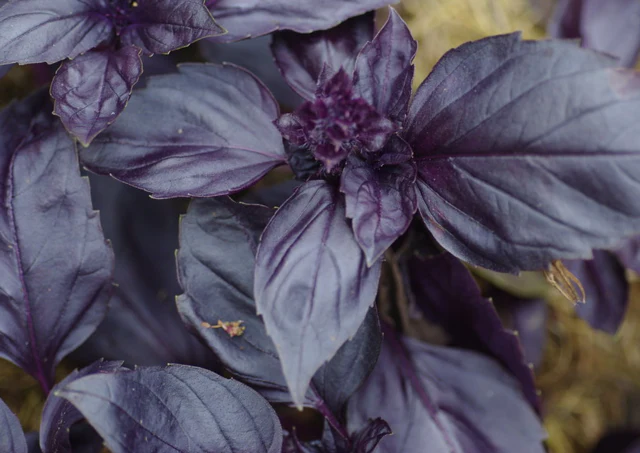
Here are the steps to plant Red Rubin basil:
Choose a location
Before planting your red rubin basil, Select a location at prior that receives at least 6 hours of sunlight per day and has well-draining soil. Red Rubin basil can be grown in a variety of settings, including outdoor gardens, raised beds, and containers.
Prepare the soil
If you’re planting in the ground, loosen the soil to a depth of 6-8 inches and mix in some organic matter, such as compost or aged manure. If you’re planting in a container, use a potting mix that is specifically formulated for herbs or vegetables.
Plant the seeds or seedlings
If you’re starting from seed, plant the seeds 1/4 inch deep and cover lightly with soil. Water gently to moisten the soil. If you’re using seedlings, dig a hole that is slightly larger than the root ball and place the seedling in the hole. Then you should just gently tamp down the soil around the plant.
Water
Water the newly planted Red Rubin basil thoroughly to help settle the soil and ensure good root growth. Water your plant regularly, and keep the soil consistently moist but not waterlogged.
Fertilize
Red Rubin basil benefits from regular fertilization throughout the growing season. It is recommended to use a balanced, water-soluble fertilizer according to the package instructions.
Mulch
Mulching around the base of the plant can help to retain moisture and suppress weed growth.
Harvest
Red Rubin basil can be harvested as soon as it reaches a height of 6-8 inches. Pinch off the top leaves to promote bushy growth, and continue to harvest regularly throughout the growing season.
By following these steps, you can successfully plant and grow Red Rubin basil to enjoy its stunning foliage and delicious flavor.
How to care for Red Rubin basil?
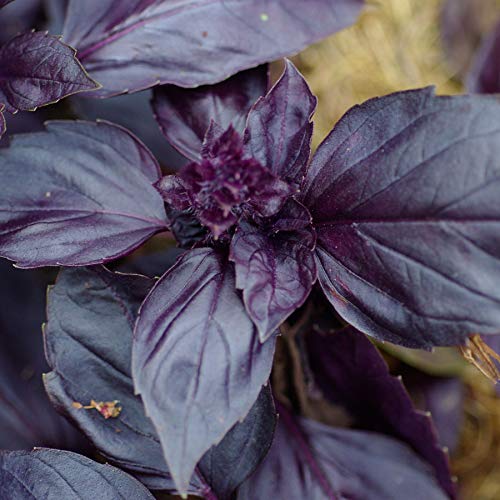
Soil
Red Rubin basil thrives in well-draining soil that is rich in organic matter. The soil should be loose and friable, with good drainage to prevent water from accumulating and causing root rot. Ideally, the soil pH should be between 6.0 and 7.0, which is slightly acidic to neutral.
If the soil is too compacted or heavy, amend it with compost, aged manure, or other organic matter to improve its texture and fertility. Red Rubin basil can be grown in a variety of settings, including outdoor gardens, raised beds, and containers, as long as the soil meets these requirements.
Light
Red Rubin basil requires full sun or partial shade to grow well. It needs at least 6 hours of sunlight per day to produce healthy, flavorful leaves. If growing indoors, the plant should be placed in a sunny south-facing window or under a grow light that provides sufficient light.
Inadequate light can cause the plant to become leggy and weak, so it’s important to provide enough light for optimal growth. While Red Rubin basil can tolerate some shade, it will not thrive in deep shade or low light conditions. Overall, providing ample light is essential for the successful cultivation of Red Rubin basil.
Water
Red Rubin basil requires regular watering to keep the soil consistently moist, but not waterlogged. The plant prefers well-draining soil that allows excess water to drain away from the roots. Outdoor plants may need to be watered more frequently during hot and dry periods, while indoor plants may require less water due to lower evaporation rates.
Overwatering can lead to root rot and other fungal diseases, while underwatering can cause the leaves to wilt and become dry. It’s important to water the plant deeply, allowing the water to penetrate the soil to a depth of at least 1 inch. By providing the right amount of water, you can help your Red Rubin basil to thrive and produce healthy, flavorful leaves.
Temperature
Red Rubin basil is a warm-season annual herb that requires warm temperatures to grow well. It prefers temperatures between 70°F and 80°F during the day and around 60°F at night. The plant is sensitive to cold and frost and will not survive freezing temperatures.
If planting outdoors, it’s important to wait until after the last frost date in your area to avoid damage to the plant. If growing indoors, make sure the temperature in the room or greenhouse is within the preferred range.
Temperature fluctuations can stress the plant and cause it to become weakened or damaged. By providing the right temperature conditions, you can ensure healthy growth and a bountiful harvest of Red Rubin basil.
Fertilizer
Red Rubin basil benefits from regular fertilization throughout the growing season to maintain its health and vigor. Fertilizer provides the essential nutrients that the plant needs to grow, develop strong stems and leaves, and produce a bountiful harvest.
The type of fertilizer and frequency of application will depend on the soil conditions and the growth stage of the plant. Generally, a balanced, water-soluble fertilizer is recommended every two to three weeks during the growing season.
Organic fertilizers, such as compost or aged manure, can also be used to improve soil fertility and add essential nutrients. It’s important not to over-fertilize, as this can lead to excessive leaf growth and reduced flavor. Follow the manufacturer’s instructions and fertilize in moderation for optimal growth and flavor
How to prune Red Rubin Basil?
Pruning Red Rubin basil is an important part of maintaining the plant’s health and encouraging bushy growth. Here are some steps to follow when pruning Red Rubin basil:
- Wait until the plant has reached at least 6-8 inches in height before pruning.
- Use a clean and sharp pair of pruning shears to make clean cuts.
- Cut back the stem just above a set of healthy leaves, leaving about 1/4 inch of stem.
- Remove any yellow or damaged leaves to improve air circulation and prevent disease.
- Pinch off the flower buds as soon as they appear to encourage more leaf growth and prevent the plant from going to seed.
- Avoid pruning more than one-third of the plant at once to prevent stress and damage.
By pruning your Red Rubin basil regularly, you can promote a bushy and healthy plant that produces a continuous supply of fresh and flavorful leaves.
How to propagate red rubin Basil?
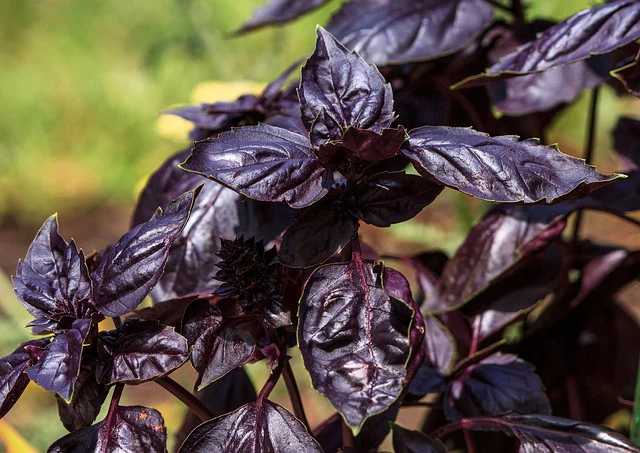
Red Rubin basil can be propagated by taking stem cuttings and rooting them in water or soil. Here are the steps to follow for propagating Red Rubin basil:
- Choose a healthy stem that is at least 4-6 inches long with several sets of leaves.
- Use clean and sharp pruning shears to make a clean cut just below a node, which is where the leaves attach to the stem.
- Remove the leaves from the bottom half of the stem, leaving only a few sets of leaves at the top.
- Dip the cut end of the stem in rooting hormone powder, if desired, to promote root growth.
- Place the stem in a jar of water or in a pot of soil, making sure the stem is covered by at least 1 inch of water or soil.
- Place the jar or pot in a warm and bright location, but avoid direct sunlight.
- Change the water in the jar every few days or keep the soil consistently moist.
- After a few weeks, roots should start to form, and the plant can be transplanted to a larger pot or garden bed.
By propagating Red Rubin basil, you can expand your plant collection and enjoy fresh, flavorful leaves all season long
How to Harvest and Use Red Rubin Basil?
Harvesting Red Rubin basil is a simple process that can be done throughout the growing season. Here are the steps to follow:
- Wait until the plant has grown to at least 6 inches tall before harvesting.
- Use clean and sharp scissors or pruning shears to snip off the stems just above a set of healthy leaves.
- Leave a few sets of leaves on the plant so it can continue to grow and produce more leaves.
- Harvest the leaves in the morning when the oils are most concentrated for the best flavor.
- Wash the leaves gently with water and pat dry with a paper towel before using.
Red Rubin basil can be used in a variety of dishes and recipes, adding a bold and distinctive flavor to salads, sandwiches, pizzas, pastas, and more. It pairs well with tomatoes, mozzarella cheese, garlic, and balsamic vinegar. The leaves can also be used to make pesto, infused oils, and vinegars. By harvesting and using Red Rubin basil, you can enjoy its delicious flavor and reap the health benefits of this nutritious herb.
Conclusion
Red Rubin basil is a beautiful and flavorful herb that is easy to grow and care for in your garden or container. By following the tips outlined in this blog post, you can ensure that your Red Rubin basil plant thrives and produces a bountiful harvest of fresh and flavorful leaves throughout the growing season.
Whether you use Red Rubin basil in salads, pasta, or sauces, this versatile herb is sure to add a burst of color and flavor to your dishes. So why not give Red Rubin basil a try in your garden or container this season and enjoy the many benefits of growing and using this delicious and nutritious herb?
You may also like to read
The Ultimate Wild Berry Harvesting Guide for Beginners
A Gardener’s Dream: Bachelor’s Button and Its Low-Maintenance Care

